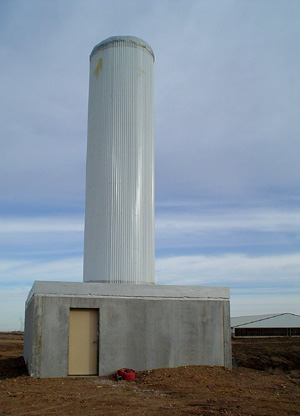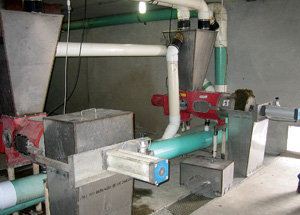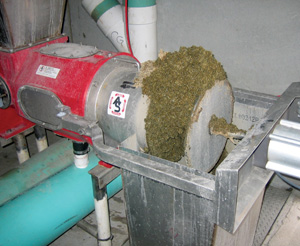
Features
Applications
Swine
Dutch manure equipment in the Dakotas
April 30, 2008 by Tony Kryzanowski
A South Dakota dairy and hog
operation, the Cedar Grove Colony, has invested in an advanced manure
management system using MAS screw press manure separators, based on
technology developed in Holland.
A South Dakota dairy and hog operation, the Cedar Grove Colony, has invested in an advanced manure management system using MAS screw press manure separators, based on technology developed in Holland.
While some religious communities shun modern technology, that certainly is not the case among Hutterites. A good example is the Cedar Grove Colony, 100 miles west of Sioux Falls, South Dakota, which has recently expanded its dairy operation to a state-of-the-art facility and installed an advanced manure management system for both its dairy and hog operations.
General manager George Hofer says the investment in advanced technology like computerized milking systems, power ventilation and rubber flooring required more cash flow, so the herd was expanded from 140 to 550 cows. Expansion of the dairy, however, has resulted in the generation of four times more manure and the need to invest in a modern manure management system.
The Environmental Protection Agency (EPA) has also developed new regulations pertaining to managing manure that had to be implemented or in process by September 2005. “Anybody who wants to stay in business has to comply,” Hofer says, noting the evolving regulations regarding manure management. “There is a world of difference between how we are handling our manure today and how it was handled in the past.”
 The holding tank for the flush water at Cedar Grove Colony. The 35-foot tall The holding tank for the flush water at Cedar Grove Colony. The 35-foot tallsilo was built adjacent to the dairy barns to hold treated lagoon water that is used to flush both the free stall and holding area barns. |
The colony consists of 30 families working as a community to grow corn, soybeans, winter wheat and alfalfa on about 6,000 acres of farmland. They also manage a 900-sow farrow-to-finish hog operation, a 280-head cow/calf operation, and now a dairy with a herd of 550 cows, which may be expanded to over 1,000 cows at some future date.
“The community is very excited about our dairy expansion,” says Hofer. “We took what we thought was the best in cow comfort from about five or six different dairies that we visited,” he explains. The result is a 50-cow Westfalia rotary milking system that is the largest of its kind in that part of the state and rather unique to the area.
The dairy construction project consisted of two 106-foot by 576-foot barns with a parlor milking system constructed from precast concrete cement walls situated in the middle. At present, one barn is a free stall barn for the milk cows, while the other houses close-up cows, fresh cows, dry cows and heifers.
Hofer says they investigated many manure management systems before making any purchasing decisions. One of their first decisions was to purchase a McLanahan sand separator. The colony decided to use sand for bedding in the dairy’s free stalls because it offered many benefits. In addition to cow comfort, Hofer says it doesn’t have to be replaced as often as other bedding material. It can usually remain in place for a week, whereas more traditional bedding requires a change-out every three days. The sand can also be recycled, which made it a more cost-effective bedding material.
However, to transport the sand-laden manure from the barn to the sand separator building, the colony needed to invest in a powerful flush system. A 35-foot tall silo was constructed adjacent to the dairy barns to hold treated lagoon water that is used to flush both the free stall and holding area barns. An 18-inch pipe leads from the silo to flush heads located at the end of each of four dairy barn alleyways. The flush system is equipped with an Agpro flush valve, which is designed to be strong enough to withstand the water pressure that it takes to push sand along the alleyways to a gutter at the end of each barn. Hofer says the height of the silo and pipe diameter provides the head pressure required by the flush system.
Another 48-foot silo built near the colony’s lagoons keeps this dairy silo full and provides water for flushing the hog barns. The hog barn pits are automatically flushed at a rate of 400 gallons per minute twice a day into a pipe that transports the manure to the colony’s manure separator building.
The dairy barn floors were constructed on a two-percent slope to improve drainage. About 6,000 gallons of water, discharged at a 10,000-gallons-per-minute rate, is automatically released every four to five hours along the alleyways. Any sand-laden manure collected there is pushed a distance of 570 feet to the gutter, which then drains the sand/manure mixture into a storage pit located in the adjacent sand separator building.
An auger in the McLanahan separator conveys the sand-laden manure at a controlled rate from the pit into the separator. Clean water is injected at the top of the separator at a rate of two to five gallons per minute. Settled sand is conveyed up the sand separator by a mining duty auger. The sand augers up the separator and drops into a pile at the end of the auger while the manure effluent is discharged from a pipe at the rear of the separator, collecting in a second stage pit. The pit is cleaned regularly with a skid steer driving down a concrete ramp to remove any sand that has been missed by the separator. A Balzer pumping unit transports the manure effluent from the pit through a pipe a distance of about 600 feet to the manure separator building.
Hofer says the colony made a conscious choice to avoid submersible pumps for all its pumping needs. “We had some problems with submersible pumps because when the seals broke, it would ruin the motor,” he says. He says the difference is that the motor on the Balzer pumping unit, which uses a Doda pump, is situated above the liquid surface. So far it has operated trouble-free. Manure from the colony’s hog operation is co-mingled with the dairy manure at the manure separator.
  The colony installed two MAS screw press manure The colony installed two MAS screw press manureseparators, supplied by Cawi Canada. The MAS separator is capable of dehydrating and separating all kinds of solid and liquid process, waste, and residue flows. At the left is the solids temporary storage area on the farm. |
The colony installed two MAS screw press manure separators, supplied by Cawi Canada Ltd and based on technology developed in Holland. The MAS separator is capable of dehydrating and separating all kinds of solid and liquid process, waste, and residue flows, and has found uses in manure processing, biogas installations, abattoirs, and the potato and vegetable industry. Raw material can be fed either from the top or from either side of the separator.
Screw rotations can vary from five to 24 rotations per minute. The special internal machine screw transports the raw material from the inlet to the press end. The screw is locked and fits precisely into the filter that surrounds it.
Beyond the filter/screw mechanism is the delivery chamber. Here, the solids are automatically compressed into a wad.
The separator is designed so that instead of leaving the machine at this point, the liquid is forced to leave the machine through the filter that surrounds the screw mechanism. Dry product leaves the machine through the delivery chamber at the end of the separator.
Hofer says because of how the separator is set up—with its cone outlet cap controlled by an air cylinder—there is less tendency to lose the consistent flowthrough of solids, or the plug. The colony is producing about 300 gallons per minute of effluent through the separator when processing flush water. When processing a higher concentration of solid/liquid manure mix, Hofer feels the separator is capable of delivering about 100 gallons per minute.
Because the counter pressure in the separator’s delivery chamber can be adjusted with great accuracy, the quality of the liquid and dry matter by-products can be easily regulated. The separator operates at a standard speed of 24 rpm, meaning that it runs very quietly. This results in less wear and tear on moving parts.
However, it is important to minimize the amount of sand and gravel transported to the separator if this is what is used for bedding, says Hofer. A small amount of sand and gravel does build up in the manure separator building’s storage pit. So the colony brings in a vacuum truck to clean out the pit once or twice a year.
The colony’s two manure separators are situated about 18 feet above ground. The solids collect in a pile below the separators and the colony is building a storage facility to house it. Because of its high nutrient value, it supplies about 10 percent of their crop fertilizer needs. Typically it is applied in the fall. About half is mixed in a mixer wagon with corn, silage and grain and is fed to the colony’s stock cows.
The liquid stream shoots through a 10-inch overflow pipe from the separators into a 500,000-gallon slurry tank. “We feel that we are catching any fines that bypass the separator in the slurry tank and we are getting some bacteria action to partly decompose any fines before they enter the lagoon,” says Hofer. “By catching most of the fines before they enter the lagoon, we feel we are getting a lot better lagoon water quality.”
The water flows by gravity from the slurry tank into a four-stage lagoon system. The system has a 90-million gallon capacity. The treated water from the fourth stage is used for both flush water and crop irrigation. Ten-inch underground pipes lead to four pivot irrigation systems located on nearby farmland.
The colony uses a John Deere diesel powered engine and a Cornell pump to transport water from the lagoon to the irrigation pivots at a rate of 2,000 gallons per minute under 100 pounds pressure. About eight million gallons are left in the lagoon system to ensure that there is enough flush water to support the dairy and hog operation.
This is where the 48-foot water storage silo is located, and it is used to store water pumped from the fourth stage of the lagoon using a Gorman-Rupp pump. Water from this silo flows by gravity to flush the hog barns and fill the dairy silo, which is about 900 feet downstream. To spread its solid fertilizer, the colony has invested in a truck-mounted Spread-All brand spreader manufactured by West Point Design Inc, in West Point, Nebraska.
As part of the colony’s overall plan to minimize its environmental impact, it has hired an engineer to design a drainage system for its feedlot, so that any liquid run-off drains into a collection pond. That liquid is also pumped into the lagoon for treatment.
The final piece of the puzzle is dealing with the lagoon’s odor. The colony has a plan to possibly install a circulation system manufactured by Circul8 Systems, located in Reardan, Washington, to minimize that impact as well.